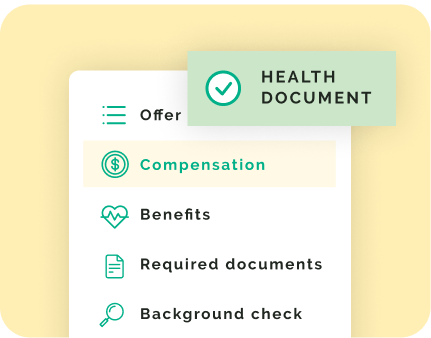As an HR professional, it’s important to know about the latest compliance laws and technologies. Recent changes in labor law make it more important than ever to stay up-to-date on the latest tools and technologies that can help you stay compliant. In this blog post, we will discuss some of the most important compliance laws and low-hanging fruit such as correct documentation, tax details, and signatures. We will also discuss some of the top tools for HR professionals such as employee management software, and databases designed for employee management.
What is HR technology and how does it help businesses stay compliant with labor laws?
Human Resources technology, or HR technology, is a solution businesses use to manage employee data. This data can include employee contact information, job descriptions, salaries, performance reviews and more. HR technology can help businesses automate many of their HR processes, such as onboarding and tracking employee hours worked.
Many employers are required to pay their employees overtime compensation for any hours worked over a certain number in a workweek. Federal and state laws vary, but the general rule is that employees must be paid time-and-a-half their regular pay rate for any overtime hours worked. Accurately calculating overtime pay can be tricky, as employers must take into account the different wage rates of their employees, as well as any bonuses or commissions that may be earned.
Employers must also keep track of the number of hours each employee works in a given workweek, as well as any time off that may have been taken. However, it is essential for employers to remain in compliance with overtime laws, as failure to do so can result in significant penalties.
Additionally, HR technology can help businesses stay compliant with labor laws by providing them with the tools they need to track employee hours, overtime and vacation days. By using HR technology, businesses can save time and money while ensuring that they are compliant with all applicable labor laws.
What are some of the most important labor laws that HR technology helps to manage and monitor?
Employee onboarding is the process of orienting and acclimating new employees to your company and its culture. This process can help ensure that your employees are productive and compliant with company policies from their first day on the job. Tracking employee hours is an essential part of onboarding, as it helps you to ensure that your employees are working the hours they are supposed to be.
In addition to being required by law, tracking employee hours can also help you to manage your budget more effectively. You can use data on employee hours worked to make informed decisions about staffing levels and budgeting for overtime hours.
There are a number of reasons why onboarding and tracking employee hours is essential for complying with labor laws.
First, by tracking employee hours, employers can ensure that employees are not working excessive hours without overtime pay.
Second, by onboarding new employees and orienting them to company policies on breaks, meal times, and other issues related to work hours, employers can help avoid potential disputes over these issues.
Finally, by maintaining accurate records of employee hours, employers will be in a better position to defend themselves against claims of violating labor laws. In short, onboarding and tracking employee hours is essential for protecting both employees and employers from potential legal problems.
What are the benefits of using HR technology to manage employee files and track hours worked/overtime pay etc?
There are many benefits to using HR technology to manage employee files and track hours worked. By automating these processes, businesses can cut down on user error and easily integrate analytics.
This allows businesses to quickly and accurately identify trends and make decisions based on data, rather than guesswork.
In addition, automating HR processes can help to free up time for HR professionals, so they can focus on more strategic tasks.
By using HR technology, businesses can improve their efficiency and accuracy, while gaining valuable insights into their workforce.
How does HR technology make it easier for employers to keep track of employee performance reviews and terminations/layoffs etc.?
Human resources technology has come a long way in recent years, making it easier than ever for employers to keep track of employee performance and compliance. One of the most popular HR technologies is the performance review system.
With this system, employers can set goals and objectives for employees, track progress over time, and identify areas where improvement is needed. This information can then be used to create action plans for individual employees or groups, ensuring that everyone is on the same page and working towards the same goals. Additionally, HR systems make it easy to keep track of employee terminations and layoffs.
Not only does this make it easier to keep track of employee performance, but it can also help to identify any issues that may arise. For example, if an employee is consistently late for their shift, HR can quickly flag this and take appropriate action.
Similarly, if an employee is regularly absent, HR can investigate the cause and decide whether or not to issue a warning or take disciplinary action. In short, HR technology makes it easier for employers to keep track of employee performance and take action when necessary.
With so much information at their fingertips, employers can quickly identify patterns and conclude which employees are not meeting their expectations. As a result, these systems help to streamline the entire process and make it more efficient. Ultimately, HR technology makes it easier for employers to keep track of employee performance and compliance, saving time and money in the long run.
Are there any drawbacks to using HR technology in your business, and if so, what are they?
While HR technology can be extremely helpful in managing employee data and automating various HR processes, there are also some potential drawbacks to using this type of technology in your business. One issue is that HR technology can be expensive to implement and maintain, especially if you need to purchase multiple licenses or subscribe to a cloud-based service.
In addition, HR technology can also create a paper trail that can be difficult to manage and search through if you need to access specific employee information. Finally, some employees may feel that they are being monitored too closely if they are constantly being tracked by an HR system.
While there are some potential drawbacks to using HR technology, these should be weighed against the potential benefits before making a decision about whether or not to implement this type of system in your business.
Is there a particular type of HR technology that’s best suited for small businesses vs. larger corporations?
When it comes to human resources, small businesses and large corporations face different challenges. Small businesses often have a smaller staff and less resources, which can make it difficult to keep track of employee records and compliance.
On the other hand, large corporations may have hundreds or even thousands of employees, spread out across multiple locations. This can make communication and coordination more challenging. As a result, the type of HR technology that’s best suited for small businesses may not be as effective for large corporations.
Small businesses may benefit from HR technologies that help to automate employee records and compliance. This can include software that tracks employee data, such as contact information, job history, and performance reviews. Having this information readily available can help small businesses to stay organized and ensure that they are compliant with all relevant laws and regulations.
Large corporations, on the other hand, may need more sophisticated HR technologies that can help to manage communication and coordination between multiple locations. This can include cloud-based systems that allow employees to access information and share documents from anywhere in the world.
Final Thoughts
HR technology can help organizations keep track of employee compliance with labor laws and prevent potential violations. By automating HR processes and tracking employee data, HR technology can help identify compliance risks and flag potential problems.
Additionally, HR technology can help to create a culture of compliance within an organization by providing employees with easy access to compliance-related information and resources.
Ultimately, HR technology can play a key role in helping organizations maintain compliance with labor laws and protect their employees.












